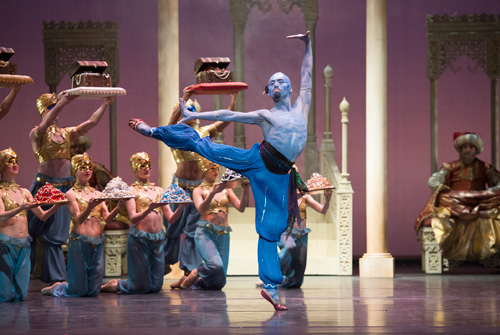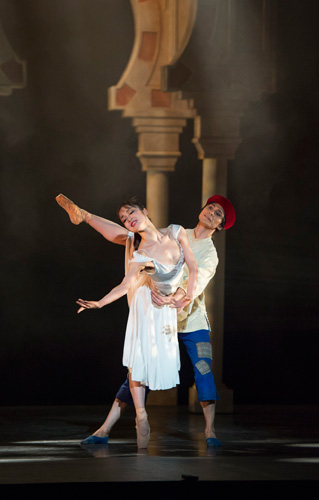Aladdin, Birmingham Royal Ballet, London Coliseum | reviews, news & interviews
Aladdin, Birmingham Royal Ballet, London Coliseum
Aladdin, Birmingham Royal Ballet, London Coliseum
David Bintley doesn't make great claims for his family ballet, and none are needed

“Possibly the least ‘deep’ ballet I’ve ever made” - these are the words that David Bintley uses to describe his latest full-length work Aladdin, and they make rather a discouraging start to any evening. "Light" isn’t necessarily bad – work created in such a manner can often end up communicating something deeper come their unveiling.
Aladdin has been a long time coming, with the composer Carl Davis initially mentioning it to Bintley in 2006. The work was eventually created for the National Ballet of Japan in 2008, another reason (according to Bintley) for any obvious weaknesses the production might have: “working with an inexperienced company slows things down... the result is a ballet that does what it says on the tin”.
It doesn’t demand nearly enough from the capable dancers
Most people born post-1980 will probably relate Aladdin to the Disney franchise rather than it’s more weighted (though questionable) literary origins, and Bintley has undoubtedly created a family ballet. Competing directly with Disney is a tricky one, as animation knows almost no boundaries; Dick Bird’s sets can look too bare at times, yet certain scenes still have a wow factor: the cave of riches with its bone-like sprawling staircase and neon-esque stalactites/stalagmites is highly evocative. And the onstage running water of the bathhouse scene is a fine technical feat. Sue Blane’s costume designs work well throughout, with the Diamond’s geometric tutus in particular a stroke of brilliance.
 Davis’s score is a rich one, heavily reworked from the original 2001 version created for Scottish Ballet’s Robert Cohan offering. It leans towards the generic by the end of the evening, but still has atmospheric melodies that conjure up the exotic geography of the locations, aided by the commendable playing of the Royal Ballet Sinfonia, conducted by Paul Murphy.
Davis’s score is a rich one, heavily reworked from the original 2001 version created for Scottish Ballet’s Robert Cohan offering. It leans towards the generic by the end of the evening, but still has atmospheric melodies that conjure up the exotic geography of the locations, aided by the commendable playing of the Royal Ballet Sinfonia, conducted by Paul Murphy.
And what of the movement? Bintley is a vastly experienced choreographer, with a body of work ranging from short abstract pieces to full-length narrative heavies, and the overall production communicates fluidity – from the coordinated movement to the smooth linkage of the numerous scenes (minus a somewhat clunkier third act!). None of this is offensive, but it stays the wrong side of safe for almost the entire production, and doesn’t demand nearly enough from the capable dancers. Of course there are leaps and turns aplenty, but this is the kind of thing a professional dancer can do with their eyes closed.
 What’s more rewarding for them – and, consequently, for us – is seeing an actual movement language develop. This doesn’t materialise, but Aladdin offers many an attractive divergence to soften this blow; the Chinese Lion and Dragon dance are two visual highlights that linger post-performance. But lest we forget: divergence often highlights the weakness of movement when a stage is left bare bar the dancers.
What’s more rewarding for them – and, consequently, for us – is seeing an actual movement language develop. This doesn’t materialise, but Aladdin offers many an attractive divergence to soften this blow; the Chinese Lion and Dragon dance are two visual highlights that linger post-performance. But lest we forget: divergence often highlights the weakness of movement when a stage is left bare bar the dancers.
All this considered, Bintley knows how to work a crowd or corps de ballet scene skilfully, punctuated with an ingenious use of canon, as well as fine Orientalist arm movements suggesting far off mysterious locales.
The company dance the work well with César Morales (pictured with Sakuma) seemingly born to play Aladdin – with his mischievous portrayal supported by a clear technical ease reading as very watchable. And Nao Sakuma did what she could with the weak Princess Badr al-Budur role, but never truly got to show the audience the divine dancing of which she is capable.
Other standouts were Natasha Oughtred’s seductive Sapphire, Ambra Vallo and Tyrone Singleton’s crowd-pleasing/death-defying Rubies duet, and Céline Gittens’s technically dazzling Diamond from the cave’s jewel-based divertissements.
The work isn’t a flop – but equally it isn’t the hit it could have been. And considering that Birmingham Royal Ballet have the massive responsibility of defining future audiences outside London, a rethink of the commercial-v-innovation balance may be needed in order to safeguard the general public’s education about ballet.
rating
Explore topics
Share this article
The future of Arts Journalism
You can stop theartsdesk.com closing!
We urgently need financing to survive. Our fundraising drive has thus far raised £49,000 but we need to reach £100,000 or we will be forced to close. Please contribute here: https://gofund.me/c3f6033d
And if you can forward this information to anyone who might assist, we’d be grateful.

Subscribe to theartsdesk.com
Thank you for continuing to read our work on theartsdesk.com. For unlimited access to every article in its entirety, including our archive of more than 15,000 pieces, we're asking for £5 per month or £40 per year. We feel it's a very good deal, and hope you do too.
To take a subscription now simply click here.
And if you're looking for that extra gift for a friend or family member, why not treat them to a theartsdesk.com gift subscription?
more Dance
 'We are bowled over!' Thank you for your messages of love and support
Much-appreciated words of commendation from readers and the cultural community
'We are bowled over!' Thank you for your messages of love and support
Much-appreciated words of commendation from readers and the cultural community
 R:Evolution, English National Ballet, Sadler's Wells review - a vibrant survey of ballet in four acts
ENB set the bar high with this mixed bill, but they meet its challenges thrillingly
R:Evolution, English National Ballet, Sadler's Wells review - a vibrant survey of ballet in four acts
ENB set the bar high with this mixed bill, but they meet its challenges thrillingly
 Like Water for Chocolate, Royal Ballet review - splendid dancing and sets, but there's too much plot
Christopher Wheeldon's version looks great but is too muddling to connect with fully
Like Water for Chocolate, Royal Ballet review - splendid dancing and sets, but there's too much plot
Christopher Wheeldon's version looks great but is too muddling to connect with fully
 iD-Reloaded, Cirque Éloize, Marlowe Theatre, Canterbury review - attitude, energy and invention
A riotous blend of urban dance music, hip hop and contemporary circus
iD-Reloaded, Cirque Éloize, Marlowe Theatre, Canterbury review - attitude, energy and invention
A riotous blend of urban dance music, hip hop and contemporary circus
 How to be a Dancer in 72,000 Easy Lessons, Teaċ Daṁsa review - a riveting account of a life in dance
Michael Keegan-Dolan's unique hybrid of physical theatre and comic monologue
How to be a Dancer in 72,000 Easy Lessons, Teaċ Daṁsa review - a riveting account of a life in dance
Michael Keegan-Dolan's unique hybrid of physical theatre and comic monologue
 A Single Man, Linbury Theatre review - an anatomy of melancholy, with breaks in the clouds
Ed Watson and Jonathan Goddard are extraordinary in Jonathan Watkins' dance theatre adaptation of Isherwood's novel
A Single Man, Linbury Theatre review - an anatomy of melancholy, with breaks in the clouds
Ed Watson and Jonathan Goddard are extraordinary in Jonathan Watkins' dance theatre adaptation of Isherwood's novel
 Peaky Blinders: The Redemption of Thomas Shelby, Rambert, Sadler's Wells review - exciting dancing, if you can see it
Six TV series reduced to 100 minutes' dance time doesn't quite compute
Peaky Blinders: The Redemption of Thomas Shelby, Rambert, Sadler's Wells review - exciting dancing, if you can see it
Six TV series reduced to 100 minutes' dance time doesn't quite compute
 Giselle, National Ballet of Japan review - return of a classic, refreshed and impeccably danced
First visit by Miyako Yoshida's company leaves you wanting more
Giselle, National Ballet of Japan review - return of a classic, refreshed and impeccably danced
First visit by Miyako Yoshida's company leaves you wanting more
 Quadrophenia, Sadler's Wells review - missed opportunity to give new stage life to a Who classic
The brilliant cast need a tighter score and a stronger narrative
Quadrophenia, Sadler's Wells review - missed opportunity to give new stage life to a Who classic
The brilliant cast need a tighter score and a stronger narrative
 The Midnight Bell, Sadler's Wells review - a first reprise for one of Matthew Bourne's most compelling shows to date
The after-hours lives of the sad and lonely are drawn with compassion, originality and skill
The Midnight Bell, Sadler's Wells review - a first reprise for one of Matthew Bourne's most compelling shows to date
The after-hours lives of the sad and lonely are drawn with compassion, originality and skill
 Ballet to Broadway: Wheeldon Works, Royal Ballet review - the impressive range and reach of Christopher Wheeldon's craft
The title says it: as dancemaker, as creative magnet, the man clearly works his socks off
Ballet to Broadway: Wheeldon Works, Royal Ballet review - the impressive range and reach of Christopher Wheeldon's craft
The title says it: as dancemaker, as creative magnet, the man clearly works his socks off
 The Forsythe Programme, English National Ballet review - brains, beauty and bravura
Once again the veteran choreographer and maverick William Forsythe raises ENB's game
The Forsythe Programme, English National Ballet review - brains, beauty and bravura
Once again the veteran choreographer and maverick William Forsythe raises ENB's game

Add comment